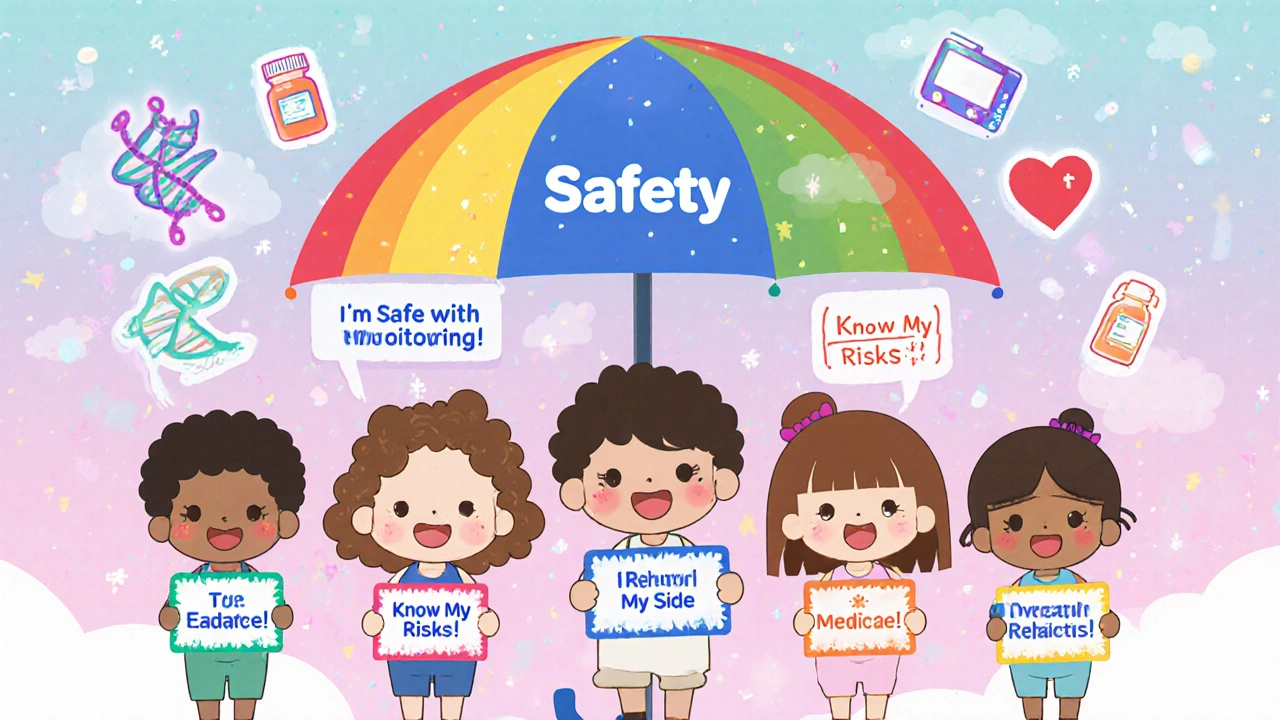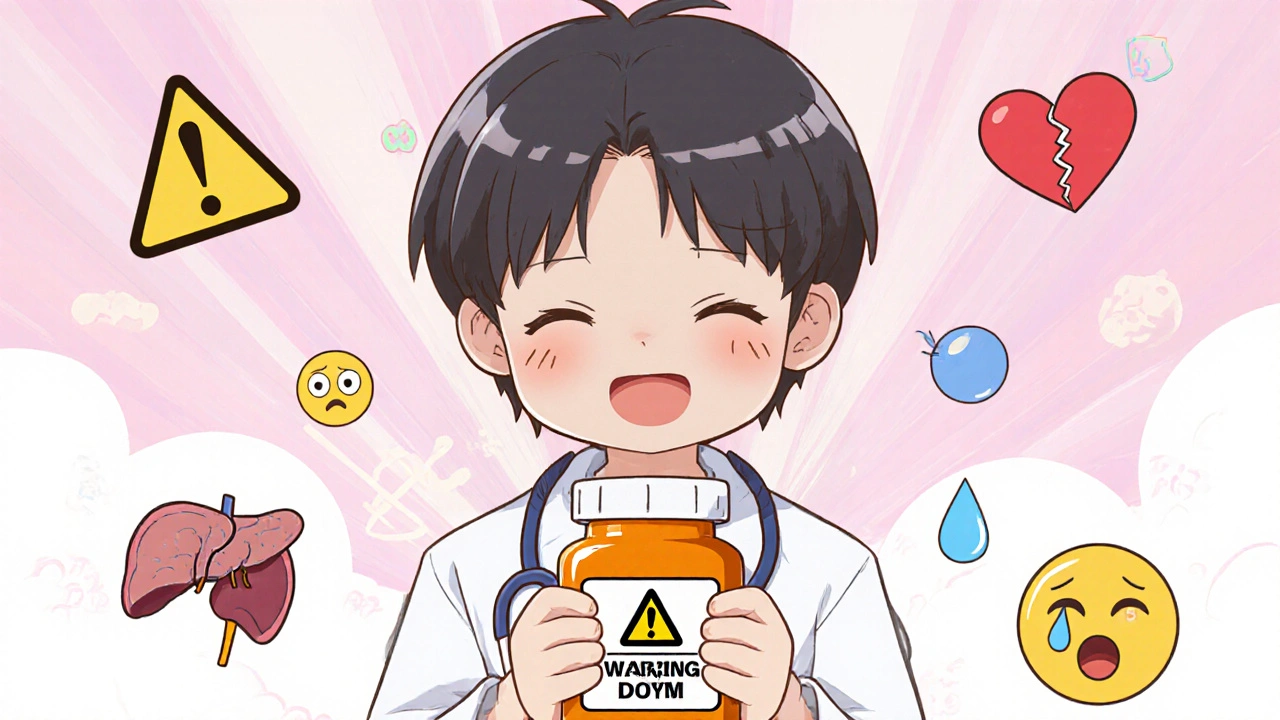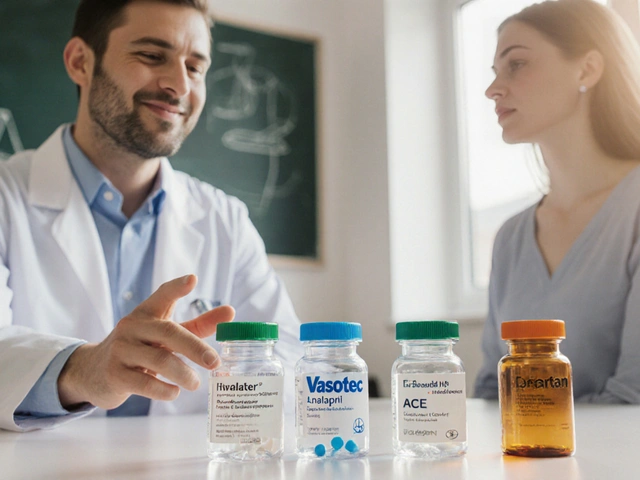Drug Safety Alert Checker
Check if your medication has an FDA black box warning
Enter a drug name to see if it carries the FDA's strongest safety warning
When you pick up a prescription, you might not notice the small black rectangle on the drug label. But that box? It’s the FDA’s loudest warning: black box warning. It’s not just a caution. It’s a red flag that says, this drug can kill you or cause serious harm-even when used exactly as directed.
What Exactly Is a Black Box Warning?
A black box warning is the strongest safety alert the U.S. Food and Drug Administration (FDA) can require on a prescription drug. It’s called that because the text is surrounded by a thick black border, making it impossible to miss in the drug’s official prescribing information. This isn’t a footnote. It’s placed right after the highlights section, where doctors and pharmacists look first.These warnings aren’t about mild side effects like headaches or nausea. They’re reserved for risks that can lead to death, permanent injury, or life-altering conditions. Think: heart failure, liver failure, suicidal behavior, severe infections, or birth defects. The FDA only puts these warnings on drugs when the danger is real, documented, and serious enough to potentially outweigh the benefits for some patients.
As of 2025, more than 400 medications carry a black box warning. That includes common drugs like antidepressants, diabetes pills, painkillers, and even some cancer treatments. Just because a drug has this warning doesn’t mean it’s unsafe for everyone. But it does mean you and your doctor need to talk-really talk-before starting it.
Why Do These Warnings Exist?
The FDA doesn’t slap black boxes on drugs lightly. Most warnings come after the drug is already on the market. That’s because some dangers only show up when thousands or millions of people use the drug over time.Here’s how it usually happens:
- A drug gets approved based on clinical trials involving a few thousand patients.
- After launch, doctors prescribe it to hundreds of thousands more.
- Reports of rare but deadly side effects start coming in through the FDA’s MedWatch system-over 1.3 million reports are reviewed each year.
- If patterns emerge-like a spike in liver damage among users over 65-the FDA investigates.
- If the evidence is strong enough, they require a black box warning.
For example, the diabetes drug rosiglitazone (Avandia) got a black box warning in 2007 after studies linked it to a higher risk of heart attacks. Prescriptions dropped by 70% within a year. But for patients with no other options, doctors still prescribed it-because the benefit of controlling dangerous blood sugar levels outweighed the risk, when managed carefully.
What Kinds of Risks Trigger a Black Box Warning?
Not all black box warnings are the same. They fall into a few key categories:- Life-threatening reactions: Drugs like fluoxetine (Prozac) carry warnings about increased suicidal thoughts in teens and young adults, especially in the first few weeks of treatment.
- Organ damage: Some antibiotics and painkillers can cause irreversible liver or kidney failure.
- Contraindications: Certain drugs are banned for people with specific conditions. For example, estrogen-containing birth control can’t be used by women with a history of blood clots.
- Special monitoring required: Drugs like methotrexate require regular blood tests to check for bone marrow suppression.
- Drug interactions: Some medications become deadly when mixed with others. For instance, combining certain antidepressants with migraine drugs can trigger serotonin syndrome-a potentially fatal condition.
Each warning includes clear language about who’s at risk, what to watch for, and what steps to take to reduce harm. It’s not just a scare tactic-it’s a roadmap for safe use.

How Do Black Box Warnings Affect Prescribing?
Doctors don’t avoid black box drugs automatically. They use them when the benefits clearly outweigh the risks. But they’re forced to think harder.Many follow the STEPS framework: Safety, Tolerability, Effectiveness, Price, Simplicity. If a drug has a black box warning, safety jumps to the top of the list. The doctor must ask: Is there a safer alternative? Can we monitor for side effects? Does the patient understand the risks?
Some drugs with black box warnings come with extra layers of protection called Risk Evaluation and Mitigation Strategies (REMS). These might include:
- Only certified prescribers can order the drug.
- Patients must enroll in a registry.
- Pharmacies can only dispense it under special conditions.
For example, the acne drug isotretinoin (Accutane) has a black box warning for severe birth defects. Its REMS program requires patients to take monthly pregnancy tests and use two forms of birth control. That’s not bureaucracy-it’s prevention.
What Should You Do If Your Drug Has a Black Box Warning?
Don’t panic. Don’t stop taking it cold turkey. Do this:- Read the warning. Ask your pharmacist for the full prescribing information. It’s not just for doctors.
- Ask your doctor: “What’s the specific risk for me?” “How often does this happen?” “Are there alternatives?”
- Know the red flags. If the warning says “watch for liver damage,” know the symptoms: yellow skin, dark urine, severe fatigue. Report them immediately.
- Keep a journal. Track how you feel, any new symptoms, and side effects. Bring it to your next visit.
- Report side effects. Use MedWatch (FDA’s online system) to report anything unusual. Your report could help save someone else’s life.
Remember: A black box warning doesn’t mean “never take this.” It means “take this with eyes wide open.”

Why Some Patients Still Take These Drugs
It’s easy to assume that if a drug has a black box warning, it’s too dangerous to use. But that’s not true for many patients.Take opioids. They carry black box warnings for addiction, overdose, and respiratory depression. Yet for someone with terminal cancer or severe trauma, the pain relief they provide is life-changing. The risk is real-but so is the benefit.
Same with antipsychotics for schizophrenia. They can cause sudden heart rhythm changes. But without them, patients may lose the ability to function, work, or care for themselves.
The key is individualization. A black box warning applies to populations. Your doctor’s job is to decide if it applies to you.
How the FDA Is Making Warnings Better
The FDA isn’t sitting still. In 2021, they updated labeling rules to make black box warnings clearer and easier to find. They’re also using data from over 300 million electronic health records through the Sentinel Initiative to spot dangers faster.Future updates may include pharmacogenomic alerts-warnings tailored to your DNA. For example, a drug might say: “Avoid if you have the HLA-B*15:02 gene variant,” which increases risk of a severe skin reaction. This moves black box warnings from broad to precise.
Pharmaceutical companies are now building safety monitoring into clinical trials from day one. They’re looking for signals earlier, so fewer drugs get to market with hidden dangers.
Final Thought: Knowledge Is Your Shield
Black box warnings exist because people have died from drugs that seemed safe on paper. The FDA doesn’t want that to happen again. But no system is perfect. The most powerful tool you have isn’t the warning itself-it’s your ability to ask questions, listen, and act.If you’re prescribed a drug with a black box warning, don’t accept silence. Push for clarity. Demand answers. Understand the numbers. Know your risks. And never assume that just because a drug is FDA-approved, it’s automatically safe for you.
Medication is powerful. So is information. Use both wisely.
Do all drugs with black box warnings have to be avoided?
No. A black box warning means the drug carries serious risks, but it doesn’t mean it’s always unsafe. Many patients benefit from these medications when the risks are carefully managed. For example, antidepressants with black box warnings for suicidal thoughts are still prescribed to teens when the benefits outweigh the risks, especially when monitored closely by a doctor.
Can a black box warning be removed?
Yes. If new evidence shows the risk is lower than originally thought-or if safety measures like monitoring or patient education reduce harm-the FDA can remove or modify the warning. This requires new clinical data and review. For example, some older warnings for birth control pills were updated as research showed lower risks than previously believed.
Are over-the-counter drugs ever given black box warnings?
No. Black box warnings only apply to prescription medications. Over-the-counter drugs may have strong warnings on the label, but they don’t get black boxes. That’s because the FDA considers prescription drugs to carry higher risks and require professional oversight.
How do I find out if my medication has a black box warning?
Check the prescribing information that comes with your prescription. You can also search the FDA’s Drugs@FDA database online or ask your pharmacist for the full package insert. Many pharmacy apps now highlight black box warnings directly in the medication profile.
Do black box warnings mean the drug is dangerous for everyone?
No. Black box warnings apply to potential risks in certain groups-like people with specific health conditions, genetic markers, or those taking other medications. Many people take these drugs safely. The warning is there to help doctors and patients make informed decisions, not to ban the drug outright.







Molly Britt
October 31, 2025My aunt died from a black box drug. They told her it was safe. She believed them. Now I don't trust anything with a label.